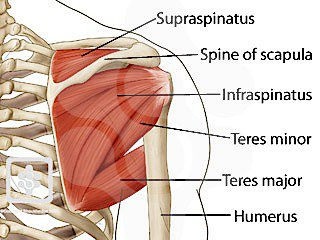Shoulder treatment - let's debunk some common myths

Shoulder pain and lack of movement are one of the most common problems a Physiotherapist can see. Whilst the anatomy, bio-mechanics and pathology can be complex, their treatment should not be.
Below I would like to eradicate some of the myths that still exist in many other clinicians practices.
Before we discuss best practice for shoulder treatment, its will be better to explain what is moving and being moved within the shoulder.
Anatomy We call the shoulder a shoulder complex. Because it is just that. It is complex due to the number of bones that articulate (move) within this joint. We have the humerus (arm bone) the scapula (shoulder blade) and the clavicle (collar bone) Moving all of these bones, we have:

Collectively called the rotator cuff. In simple terms, the group of muscles that stabilise and initiate all movements of the shoulder.
Pathology
Or: What can go wrong? 1. Frozen Shoulder or Adhesive capsulitis

The Shoulder doesn't freeze. The term refers to the joint capsule shrinking and thickening which limits and reduces the range of motion of the shoulder. This can come with or without pain.
2. Degenerative changes For example: Arthritis or calcification.

Like in any other joint, arthritis is where the once shiny, smooth hyaline cartilage wears away and is replaced with thicker, rougher bone.
This usually comes with pain and a lack of movement within the shoulder.
3. Muscle weakness / tear

The rotator cuff work as a seamless team. Any disruption to one or some of these muscles can cause an imbalance to the usual smooth movement of the shoulder, causing pain and often a lack of movement within the shoulder.
Debunk the myths
1. If I have a scan, it'll show me what is wrong and we can treat accordingly
Yes. And; NO! Whilst it may show anything going on underneath the skin, the similar can be said for those who are not suffering pain or a lack of movement.
In a study by Grish et al (2011) of 51 people between 40 - 70, 96% had something wrong in the absence of pain! More recently, Roddy et al (2015) looked at 256 participants and found no benefit from imagery when rehabilitating people with shoulder pain, with or without imagery.
2. A frozen shoulder has a natural history and resolves itself over time
Completely false! This myth was identified at the start of the year by Wong et al (2017) who identified that this stemmed from a heavily biased study dating more than 70 years old! The study from the 1940's was based on a series of participants asked to not move their shoulder for several weeks. If any shoulder was placed into a sling for several weeks, it is going to be stiff and weak! Thanks to the study by Wong et al (2017). we also know these do not have a natural history of self-resolving. Hard work from your therapist and the patient of mobilisations and exercises are needed to gain as much range of motion as possible in the first 3 months. Equally, there is no evidence to suggest full range of motion can be restored.
3. I need surgery to remove the bony prominence under my shoulder
Not necessarily true. Whilst sub-acromial decompression is still carried out by many, the evidence for their efficacy is questionable. Lewis (2011) looked into this in great detail. He identified that whilst an ultrasound or x-ray may show the presence of a bony growth (calcification), there was
no abrasion caused by this bony prominence
no inflammation
no muscular tears in the area of the calcification
Later on, Ketola et al (2013) identified in their study, no significant difference between groups of surgery and non-surgical intervention when given rehabilitation exercises.
Finally, Littlewood et al (2015) identified in their own study, a significant improvement when giving people with known calcification loaded, strengthening exercises only.
4. My image has identified a muscle tear, it needs to be repaired.
Again, not necessarily true. A study by Frost et al (1999) identified that as many as 40% of the general population will have some form of muscle tear in the absence of pain and lack of movement
This was extended by Littlewood et al (2016) in their study that identified that this percentage increases, so much so that at age 60, 100% of the population will have something wrong inside of their shoulder, with or without the absence of pain and lack of movement.
We now know that our body naturally tears our muscle fibres as we age in order for us to maintain our full range of motion in the shoulder. By repairing these natural tears, we risk losing our full range of motion.
With all of this said, how is treating the shoulder so easy?
The most common reason for shoulder pain and reduced movement is in simple terms, a weakness in the rotator cuff muscles. In a distant 2nd and 3rd, is a frozen shoulder and arthritic changes. Other problems must be considered and eliminated through an accurate assessment, but muscle weakness is the main reason for shoulder pain and lack of movement.
Loading and strengthening the rotator cuff over a period of time sees many reduce their pain and increase their of movement. Explanation of the above in a sutsynch manner to help eradicate many psychosocial issues and therefore debunking these myths is equally necessary too. I have used this approach for over a year now and have had 100% success when using these principles. If you or anyone you know have a painful, limited shoulder, then contact Mike Stamp Physio & Pilates on 07399 500545. Make sure you like us on Facebook: Facebook.com/mikestampphysiotherapy



















